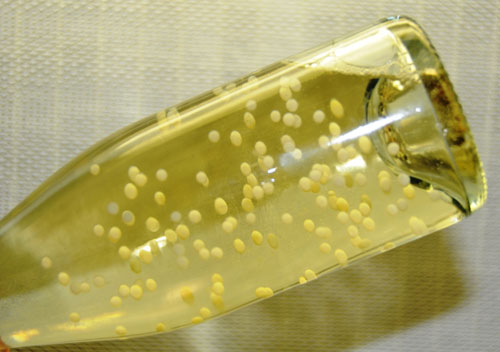Industrial fermentations utilizing yeasts are the brewing of beer, the production of Baker’s Yeast (biomass) and recent processes have also been established for the production of recombinant products.
Brewing
 |
| Inocula for Yeast Process |
- Yeast can be used to inoculate a fresh batch of wort from previous fermentation or from propagator.
- It is common practice in the British brewing industry to use the yeast from the previous fermentation.
- The brewing terms used to describe this process and 'crop', referring to the harvested yeast from the previous fermentation, and 'pitch', meaning to inoculate.
- One of the major factors contributing to the continuation of this practice is the wort-based excise laws in the United Kingdom where duty is charged on the sugar consumed rather than the alcohol produced.
- Thus, dedicated yeast propagation systems are expensive to operate because duty is charged on the sugar consumed by the yeast during growth.
- The problems with this technique are chances of contamination and degeneration of strains, the most common problem with the degenerated cell is the change in the degree of flocculence and weakening of abilities of the yeast.
- In breweries employing top fermentations in open fermenters these dangers are minimized by collecting yeast to be used for future pitching from 'middle skimmings’'.
- As the head of yeast develops, the surface layer (the most flocculent and highly contaminated yeasts) is removed and discarded and the underlying cells (the 'middle skimmings') are harvested and used for subsequent pitching.
- Therefore, the 'middle skimmings' contain cells which have the desired flocculence and which have been protected from contamination by the surface layer of the yeast head.
- The pitching yeast may be treated to reduce the level of contaminating bacteria and remove protein and dead yeast cells by such treatments as reducing the pH of the slurry to 2.5 to 3, washing with water, washing with ammonium persulphate and treatment with antibiotics such as polymixin, penicillin and neomycin.
- However, traditional open vessels are becoming rare and the bulk of beer is brewed using cylindro-conical fermenters.
- In these systems the yeast flocculates and collects in the cone at the bottom of the fermenter where it is subject to the stresses of nutrient starvation, high ethanol concentration, low water activity, high carbon dioxide concentration and high pressure, which decreases the viability and physiological state of the yeast crop, would not be ideal for an inoculum.
- The situation is further complicated by the fact that the harvested yeast is stored rapidly to about 1°, before it is used as inoculum suspending in beer and storing in the absence of oxygen.
- Thus, we have the irregularity of oxygen being required for sterol synthesis; yet anaerobic conditions are required for ethanol production.
- This irregularity is resolved traditionally by aerating the wort before inoculation.
- The difficulties outlined above and the likelihood of strain degeneration and contamination mean that are rarely used for more than five to ten consecutive fermentations which necessitates the periodical production of a pure inoculum.
- Pure inocula can be prepared by a yeast propagation scheme utilizing a 10% inoculum volume at each stage in the programme and employing conditions similar to those used during brewing.
- Continuous aeration may be used during the propagation stage which seems to have little effect on the beer produced in the subsequent fermentation.
- Yeast inoculum produced in this way would also be sterol rich, obviating the need for aerated wort.
- The simplest type of propagator is a single stage system resembling an unstirred, aerated fermenter which is inoculated with a shake-flask culture developed from a single colony.
- Two-stage systems propagator could be operated semi-continuously. It consisted of two linked vessels, 1.5 and 150 dm3 respectively.
- The smaller vessel is filled with wort, sterilized, cooled, aerated and inoculated with a flask-grown culture. After growth for 3 to 4 days the culture was forced by air pressure into the second vessel which had been filled with sterilized, cooled wort and aerated.
- An aliquot of 1.5 dm3 was forced back into the first vessel after mixing. In a further 3 to 4 days the larger vessel contained sufficient biomass to pitch a 1000 dm3 fermenter and the first vessel contained sufficient inoculum for another second stage.
- However, although this procedure should produce a pure inoculum there is a danger of strain degeneration occurring in such a semi-continuous system.
Baker's Yeast
- The commercial production of bakers' yeast involves the development of an inoculum through a large number of aerobic stages.
- Although the production stages of the process may not be operated under strictly aseptic conditions a pure culture is used for the initial inoculum, thereby keeping contamination to a minimum in the early stages of growth.
- The development of inoculum for the production of bakers' yeast involve eight stages, the first three being aseptic while the remaining stages were carried out in open vessels.
- The yeast may be pumped from one stage to the next or the seed cultures may be centrifuged and washed before transfer, which reduces the level of contamination.
- The yields obtained in the first five stages are relatively low because they are not fed-batch systems, whereas the last three stages are fed-batch.
Comments
Post a Comment